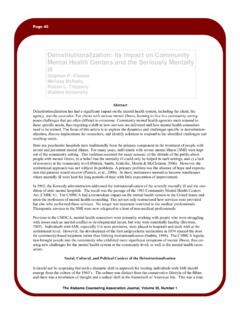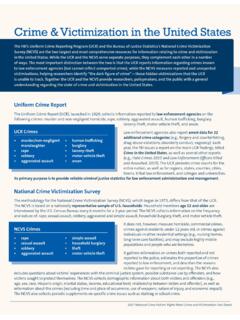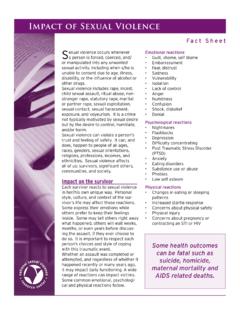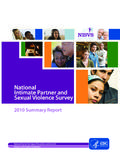Transcription of Prevalence and Characteristics of Sexual Violence ...
1 Surveillance Summaries / Vol. 63 / No. 8 September 5, 2014 Department of Health and Human ServicesCenters for Disease Control and PreventionMorbidity and Mortality Weekly ReportPrevalence and Characteristics of Sexual Violence , Stalking, and Intimate Partner Violence victimization National Intimate Partner and Sexual Violence Survey, United States, 2011 Surveillance SummariesCONTENTSI ntroduction ..2 Methods ..3 Results ..4 Discussion ..15 Limitations ..17 Conclusion ..17 Acknowledgments ..17 References ..17 The MMWR series of publications is published by the Center for Surveillance, Epidemiology, and Laboratory Services, Centers for Disease Control and Prevention (CDC), Department of Health and Human Services, Atlanta, GA citation: [Author names; first three, then et al., if more than six.] [Title]. MMWR 2014;63(No. SS-#):[inclusive page numbers].
2 Centers for Disease Control and PreventionThomas R. Frieden, MD, MPH, Director Harold W. Jaffe, MD, MA, Associate Director for Science Joanne Cono, MD, ScM, Director, Office of Science Quality Chesley L. Richards, MD, MPH, Deputy Director for Public Health Scientific ServicesMichael F. Iademarco, MD, MPH, Director, Center for Surveillance, Epidemiology, and Laboratory Services MMWR Editorial and Production Staff (Serials)Charlotte K. Kent, PhD, MPH, Acting Editor-in-ChiefChristine G. Casey, MD, EditorTeresa F. Rutledge, Managing EditorDavid C. Johnson, Lead Technical Writer-EditorJeffrey D. Sokolow, MA, Project EditorMartha F. Boyd, Lead Visual Information SpecialistMaureen A. Leahy, Julia C. Martinroe, Stephen R. Spriggs, Terraye M. StarrVisual Information SpecialistsQuang M. Doan, MBA, Phyllis H. KingInformation Technology SpecialistsMMWR Editorial BoardWilliam L.
3 Roper, MD, MPH, Chapel Hill, NC, ChairmanMatthew L. Boulton, MD, MPH, Ann Arbor, MIVirginia A. Caine, MD, Indianapolis, INJonathan E. Fielding, MD, MPH, MBA, Los Angeles, CADavid W. Fleming, MD, Seattle, WAWilliam E. Halperin, MD, DrPH, MPH, Newark, NJKing K. Holmes, MD, PhD, Seattle, WATimothy F. Jones, MD, Nashville, TNRima F. Khabbaz, MD, Atlanta, GADennis G. Maki, MD, Madison, WIPatricia Quinlisk, MD, MPH, Des Moines, IAPatrick L. Remington, MD, MPH, Madison, WIWilliam Schaffner, MD, Nashville, TNSurveillance SummariesMMWR / September 5, 2014 / Vol. 63 / No. 8 1 Prevalence and Characteristics of Sexual Violence , Stalking, and Intimate Partner Violence victimization National Intimate Partner and Sexual Violence Survey, United States, 2011 Matthew J. Breiding, PhDSharon G. Smith, PhDKathleen C. Basile, PhDMikel L. Walters, PhDJieru Chen, MSMelissa T.
4 Merrick, PhDDivision of Violence Prevention, National Center for Injury Prevention and Control, CDCA bstractProblem/Condition: Sexual Violence , stalking, and intimate partner Violence are public health problems known to have a negative impact on millions of persons in the United States each year, not only by way of immediate harm but also through negative long-term health impacts. Before implementation of the National Intimate Partner and Sexual Violence Survey (NISVS) in 2010, the most recent detailed national data on the public health burden from these forms of Violence were obtained from the National Violence against Women Survey conducted during 1995 report examines Sexual Violence , stalking, and intimate partner Violence victimization using data from 2011. The report describes the overall Prevalence of Sexual Violence , stalking, and intimate partner Violence victimization ; racial/ethnic variation in Prevalence ; how types of perpetrators vary by Violence type; and the age at which victimization typically begins.
5 For intimate partner Violence , the report also examines a range of negative impacts experienced as a result of victimization , including the need for Period: January December, of System: NISVS is a national random-digit dial telephone survey of the noninstitutionalized English- and Spanish-speaking population aged 18 years. NISVS gathers data on experiences of Sexual Violence , stalking, and intimate partner Violence among adult women and men in the United States by using a dual-frame sampling strategy that includes both landline and cellular telephones. The survey was conducted in 50 states and the District of Columbia; in 2011, the second year of NISVS data collection, 12,727 interviews were completed, and 1,428 interviews were partially : In the United States, an estimated of women and of men have been raped during their lifetimes; an estimated of women reported that they were raped in the 12 months preceding the survey.
6 The case count for men reporting rape in the preceding 12 months was too small to produce a statistically reliable Prevalence estimate. An estimated of women and of men experienced other forms of Sexual Violence during their lifetimes, including being made to penetrate, Sexual coercion, unwanted Sexual contact, and noncontact unwanted Sexual experiences. The percentages of women and men who experienced these other forms of Sexual Violence victimization in the 12 months preceding the survey were an estimated and , estimated of women and of men have been a victim of stalking during their lifetimes. An estimated of women and of men were stalked in the 12 months preceding the respect to Sexual Violence and stalking, female victims reported predominantly male perpetrators, whereas for male victims, the sex of the perpetrator varied by the specific form of Violence examined.
7 Male rape victims predominantly had male perpetrators, but other forms of Sexual Violence experienced by men were either perpetrated predominantly by women ( , being made to penetrate and Sexual coercion) or split more evenly among male and female perpetrators ( , unwanted Sexual contact and noncontact unwanted Sexual experiences). In addition, male stalking victims also reported a more even mix of males and females who had perpetrated stalking against lifetime and 12-month prevalences of rape by an intimate partner for women were an estimated and , respectively; an estimated of men experienced rape by an intimate partner during their lifetimes, although the case count for men reporting rape by an intimate partner in the preceding Corresponding author: Matthew J. Breiding, Division of Violence Prevention, National Center for Injury Prevention and Control, CDC.
8 Telephone: 770-488-1396; E-mail: Summaries2 MMWR / September 5, 2014 / Vol. 63 / No. 8 Before implementation of the National Intimate Partner and Sexual Violence Survey (NISVS) in 2010, the most recent data on the national public health burden of Sexual Violence , stalking and intimate partner Violence victimization came from the National Violence Against Women Survey, which was administered one time during 1995 1996 (3). This report examines these three forms of Violence from the second year of NISVS data collection. The report describes overall Prevalence of Sexual Violence , stalking, and intimate partner Violence victimization by sex; racial/ethnic variation in Prevalence ; how the type of perpetrator varies by Violence type; and the age at IntroductionSexual Violence , stalking, and intimate partner Violence are important public health problems that affect the lives of millions of persons in the United States.
9 These forms of Violence can lead to serious short- and long-term consequences including physical injury, poor mental health, and chronic physical health problems (1,2). For some persons, Violence victimization results in hospitalization, disability, or death. Furthermore, previous research indicates that victimization as a child or adolescent increases the likelihood that victimization will reoccur in adulthood (3,4).12 months was too small to produce a statistically reliable Prevalence estimate. An estimated of women and of men experienced other forms of Sexual Violence by an intimate partner during their lifetimes, whereas an estimated of both men and women experienced these forms of Sexual Violence by a partner in the 12 months before taking the survey. Severe physical Violence by an intimate partner (including acts such as being hit with something hard, being kicked or beaten, or being burned on purpose) was experienced by an estimated of women and of men during their lifetimes and by an estimated of women and of men in the 12 months before taking the survey.
10 Finally, the lifetime and 12-month Prevalence of stalking by an intimate partner for women was an estimated and , respectively, while the lifetime and 12-month Prevalence for men was an estimated and , victims of Sexual Violence , stalking, and intimate partner Violence were first victimized at a young age. Among female victims of completed rape, an estimated were first raped before age 25 years ( before age 18 years). Among male victims who were made to penetrate a perpetrator, an estimated were victimized before age 25 years ( before age 18 years). In addition, an estimated of female stalking victims and of male stalking victims were first stalked before age 25 years ( of female victims and of male victims before age 18 years). Finally, among victims of contact Sexual Violence , physical Violence , or stalking by an intimate partner, an estimated of women and of men first experienced these or other forms of intimate partner Violence before age 25 years ( of female victims and of male victims before age 18 years).

















